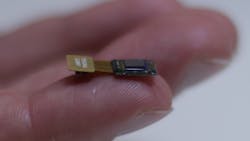Last year, IHS predicted that the by end of 2019, new security cameras will be generating more than 2,500 petabytes of data daily. That stands in stark contrast to the 566 petabytes of daily data that was generated by surveillance cameras in 2015, which is still astronomical considering that would equal nearly all of Netflix’s current subscribers streaming over an hour of ultra-high definition content simultaneously, according to the research firm. The much ballyhooed world of big data is now a reality in video surveillance, but while the number of cameras installed globally number in excess of 240 million with more coming online every year, they still have deployment limitations.
However, two researchers at Rice University have developed a camera technology, known as FlatCam, which has the potential to make cameras even more ubiquitous in public spaces. FlatCam is a lensless camera that is less than a millimeter thick and can be placed almost anywhere an end-user sees fit. According to Richard G. Baraniuk, Professor of Electrical and Computer Engineering at Rice, who recently delivered a presentation at the annual Milestone Integration Platform Symposium (MIPS) in San Antonio, the idea behind FlatCam was really about rethinking how cameras take pictures and whether it’s possible to change their form factor.
“There’s this whole area of computational imaging that really enables new ways to think about sensing all kinds of different phenomena and the fundamental tradeoff that it allows you to make is between computation on a computer and hardware,” Baraniuk says. “We asked the question of whether it was possible to use computations in order to replace, in this case, the lens in a camera. And it turns out, that can be done.”
Baraniuk says that FlatCam was developed as a general purpose concept but there are obviously some sweet spots for the technology in addition to security, including the medical and scientific fields. However, he added that it’s not supposed to be a panacea for any particular market.
Ashok Veeraraghavan, Assistant Professor of Electrical and Computer Engineering at Rice, who helped develop FlatCam with Baraniuk, says one of the obvious benefits of FlatCam is that it allows for cameras to be placed on a variety of different surfaces due to its small size.
“Think about a camera on your shirt, flexible surfaces, on top of your skin or your watch… this is technology that is ideal for that,” Veeraraghavan says. “Another key facet of the technology is that because lenses and integration modules are removed, it’s just a sensor and it becomes extremely light. You can imagine small drones that could carry these cameras today because the weight comes down by a factor of 10.”
Of course, costs for producing FlatCam are also extremely low given that the lenses and camera modules are eliminated. As a result, places where end-users would like to have cameras today but don’t because they are cost prohibitive, would no longer find price to be an issue.
“The device would presumably, in volume, cost less than a dollar,” Veeraraghavan adds. “You can imagine all of these electronic devices where you need sensors but don’t usually use cameras having cameras in them.”
However, because the cameras are only capable of producing 1-megapixel resolution currently, Veeraraghavan says they are not meant to be used in places where high-resolution imaging is a must. Baraniuk says they could easily generate more megapixels with the camera, but the tradeoff they’re making with FlatCam to make it in its current form factor is not going to produce SLR-quality images.
Regardless of where or how someone wants to use FlatCam, the idea is that they could all be connected via Wi-Fi
“We’re moving into a world where everything is going to be Wi-Fied together in the so-called Internet of Things and the really exciting possibility is that you could literally, in a space or around the world, have millions of these kinds of sensors that can be used for all kinds of different applications. Because they’re so inexpensive, they can basically be installed in stuff or even just dropped places to opportunistically sense interesting phenomena. From the standpoint of the security and surveillance world, this is a really an exciting future direction for that space.”
Although FlatCam will not be able to compete with traditional surveillance cameras in terms of its functionality, what it lacks in features will be more than made up for in volume. In areas covered today by pan/tilt/zoom or panoramic cameras that can cost thousands of dollars, end-users could just simply flood an area with FlatCams at a fraction of the cost and achieve the same result.
“The idea is that these cameras should be like Band-Aids; you peel them off, stick them in a place and they’ll operate for maybe six months to a year. But the bottom line is they are so inexpensive, so easy to install and use that you would use many, many of them without having to worry about cost,” Veeraraghavan explains.
Veeraraghavan says their plan is to create a consortium around the technology consisting of sponsors from various industries to help drive further research around it and eventually bring it to market through licensing agreements.



